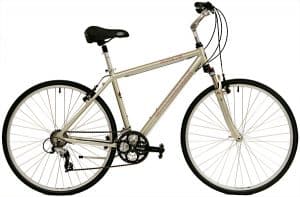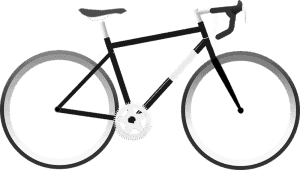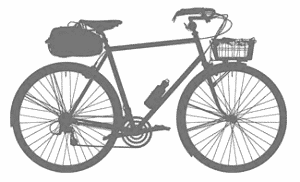
Choosing the right new or used bike for getting around town.
We get the question “How do I buy a bike?” a lot. Knowing which bike is right for you comes down to figuring out a few things: 1. What you will you be using the bike for and 2. The right physical fit.
Where to get a bike
PLEASE NOTE: Below I won’t say anything about not say Walmart, Dicks, or Target. These locations may be ok for kids bikes, but I will advise you not to buy a bike at a big box store…the reason being is they can be unsafe due to improper assembly by untrained mechanics, the quality is low and they will only last you so many miles before they become garbage–many of these bikes do not have replaceable parts.
Building your own bike & co-ops
It’s an undertaking, but it is a super transformative experience. If you’re buying new parts to build a bike, you will end up spending more money than if you brought a new build bike from your local bike shop. You’ll know your bike inside and out! There are a number of bike co-ops in Pittsburgh where you may use their tools, including Free Ride, Kraynicks, future Burgess St Bike Garage, and the Alley Bike Co-op.
Free Ride
Free Ride is Pittsburgh’s DIY Bicycle Collective, dedicated to recycling bicycles and mechanical bicycle education, helping people of all ages and backgrounds obtain, maintain, and repair bicycles. Here you can purchase used bike parts or a used bicycle, work on your bike during open shop hours, or volunteer your time to earn credit towards bicycle parts.
Craigslist
I suggest reading our blog post which will tell you all about finding a bike on Craigslist. You might find something for $100, but expect to spend at least $200+ if you want an operable bicycle. Bikes will be listed higher than $200, even at $1000 depending on the brand, condition, and style of bicycle.
You may be asking, “how do I know if this is the right bike for me?” so I urge you to keep reading as we will answer all of those questions!
Bike Shops
Your local bike shop is one of the best resources! You may have shied away from the small shop because you’re not a “bike person” (yet!), and that can be very intimidating.
The folks at your local bike shop are there to help. They are skilled, knowledgeable, and want to help. You might spend a little more money at your local shop, but cost is more than made up for in the lifetime of your product, service, and smiles.
Even if you’ve settled on one style of bicycle, take at least one other style of bike out for a test ride. It’s great to feel the comparison to know that you’re making the best decision.
Used bikes at bike shops
These bikes shops have recycled bicycles and tuned them up really well so they’re ready to roll: Thick Bikes, Bicycle Heaven, and Love Bikes.
New bikes at bike shops
Find a salesperson there that you feel comfortable talking to and don’t be afraid to ask all of the questions.
Choosing the right bicycle style for you
Where will you be riding? Trails, the park, pavement… How do you typically carry things? What type of position would you be most comfortable riding in? A super aerodynamic one, upright, or somewhere in between?
Start Here:
The Frame! The frame is the base of your bike and makes up about half the cost of your bicycle. It determines what type of bike you have (though it can be modified in various ways), and sets limits for what you can or cannot do with your bike. Frames can be made of different materials, come in different shapes as you see above, and come in different sizes.
- Steel and Aluminum are the most common frame materials, and all you should really consider unless you are a competitive cyclist and/or looking to spend a lot of money. Steel is strong and offers flex for a comfortable ride. Aluminum is lighter weight than steel, but is also stiffer.
- Shape or geometry of the bicycle as seen above affects your body position on the bicycle as well as how the bicycle handles different surfaces. Tighter geometries are quicker and more rigid or sensitive, while longer geometries provide more stability.
- Size is very important in making sure that you aren’t riding something too big or too small–this can actually cause injuries. Bicycles can be fit in a number of ways to make sure that the saddle, handlebars, and more are positioned for comfort and injury prevention.
- General rule is to have 1” of top tube clearance for road, cyclocross, touring, track bikes, and 3-4” for hybrid and mountain bikes
- The frame will determine things like: tire size clearance, rack mounts, ability for gearing or not, and brake type.
Bike styles you see around town
Mountain Bike

There is a common misconception that because Pittsburgh has hills and potholes that you will need a mountain bike. While it’s perfectly ok to use one on the road, mountain bikes are for most suited for mountain biking rather than getting around town with their knobby tires, suspension, and geometry.
Where: Wooded Trails
Body Position: Upright
Bags, Racks, Fenders – Not really
Hybrid
 Larger tire and upright position for comfort, Good for multiple surfaces and trail rides
Larger tire and upright position for comfort, Good for multiple surfaces and trail rides
Geometry is great for casual easy paced riding, not optimal for long distances or speed
Where: Trails, Streets
Body Position: Upright
Bags, Racks, Fenders – Typically Good
Track Bike

The minimalist’s bicycle. Compact geometry, intended for single-speed fixed gear racing, but also used on the street by some. This is not your all-around practical bike and has few accouterments. Light weight, less maintenance, but incompatible with many mid to larger sized tires, limited to no ability to attach racks, cannot have gears unless you have an internally geared hub.
Where: Roads – Flat (not good for hills)
Body Position: Forward
Bags, Racks, Fenders – No
Road Bike

Road bikes–classic and modern–are set up for those with a need for speed. Road bikes have gears, are compact, lighter weight, and are used for sport and sometimes commuting. Road bikes usually cannot fit larger than a 28mm tire.
Where: Roads
Body Position: Forward
Bags, Racks, Fenders – Mixed. Depends on frame
Commuting/Touring

Most utilitarian style of bicycle. Flexibility with capacity to carry racks/bags, fits wide range of tire sizes. Good for trail or street.
Where: Trails, Streets
Body Position: Mid-Upright/Forward
Bags, Racks, Fenders – Yes
Other

Other types of bicycles that you might see around town include cargo bikes, folding bikes, and more! Cargo bikes can be great for carrying cargo such as kids, lots of groceries, construction supplies, you-name-it. There isn’t a huge need for folding bikes in Pittsburgh, but they sure do make sense if you’re taking your bike on the T, into your office, or if you’d rather throw your bike in the car instead of on a car rack.
Making the Buy
Know what you’re getting along with your frame including the type of wheels, gears + shifters, brakes, saddle.
As mentioned before, you should definitely take the bike for a test ride. Not only that, but try taking a bike that you don’t want for a test ride for comparison.
Don’t forget to read our blog post about buying from Craiglist.
Where to get a bike
PLEAS NOTE: Below I won’t say anything about not say Walmart, Dicks, or Target. These locations may be ok for kids bikes, but I will advise you not to buy a bike at a big box store…the reason being is they can be unsafe due to improper assembly by untrained mechanics, the quality is low and they will only last you so many miles before they become garbage–many of these bikes do not have replaceable parts.
Building your own bike & co-ops
It’s an undertaking, but it is a super transformative experience. If you’re buying new parts to build a bike, you will end up spending more money than if you brought a new build bike from your local bike shop. You’ll know your bike inside and out! There are a number of bike co-ops in Pittsburgh where you may use their tools, including Free Ride, Kraynicks, future Burgess St Bike Garage, and the Alley Bike Co-op.
Free Ride
Free Ride is Pittsburgh’s DIY Bicycle Collective, dedicated to recycling bicycles and mechanical bicycle education, helping people of all ages and backgrounds obtain, maintain, and repair bicycles. Here you can purchase used bike parts or a used bicycle, work on your bike during open shop hours, or volunteer your time to earn credit towards bicycle parts.
Craigslist
I suggest reading our blog post which will tell you all about finding a bike on Craigslist. You might find something for $100, but expect to spend at least $200+ if you want an operable bicycle. Bikes will be listed higher than $200, even at $1000 depending on the brand, condition, and style of bicycle.
You may be asking, “how do I know if this is the right bike for me?” so I urge you to keep reading as we will answer all of those questions!
Bike Shops
Your local bike shop is one of the best resources! You may have shied away from the small shop because you’re not a “bike person” (yet!), and that can be very intimidating.
The folks at your local bike shop are there to help. They are skilled, knowledgeable, and want to help. You might spend a little more money at your local shop, but cost is more than made up for in the lifetime of your product, service, and smiles.
Even if you’ve settled on one style of bicycle, take at least one other style of bike out for a test ride. It’s great to feel the comparison to know that you’re making the best decision.
Used bikes at bike shops
These bikes shops have recycled bicycles and tuned them up really well so they’re ready to roll: Thick Bikes, Bicycle Heaven, and Love Bikes.
New bikes at bike shops
Find a salesperson there that you feel comfortable talking to and don’t be afraid to ask all of the questions.
Now that you have a bike…
Additional things to buy
- Bike lock–a U-Lock is the most secure type of lock. Learn to lock your bike
- Front white light and rear red light
- Pedals–platform pedals are great for the city due to lots of starting and stopping, and work with multiple shoe types
- Helmet–learn how to wear it properly.
- Multi tool for quick fixes
- Tire levers, spare tube, patch kit
- Chain lubricant
- Anything reflective that you can add to your bicycle such as 3M reflective tape
- A BikePGH membership to support safe biking and walking
Give your bike a tune up
Even new bikes need tune-ups after being ridden, and your local bike shop usually has a window of time in which they’ll do this for free after new bike purchases. New cables stretch out and need to be re-adjusted.
You can DIY or take it to a bike shop ($40 + parts & labor)
Take a City Cycling Class to learn best practices for road safety
Learn more about the Fundamentals of City Cycling or Confident City Cycling here!
Learn about maintenance or emergency repairs
- Watch a youtube video on how to fix a flat or even take a class
- Learning about the mechanics of your bicycle will help you maintain it, and you’ll end up spending less money over time if you keep it running smoothly
Stay in touch for more resources:
Sign up for Bike Pittsburgh’s newsletter, The Messenger, to get the latest news on events, bike and pedestrian infrastructure, and fun, delivered straight to your inbox. Twice monthly emails, no spam.
Sign Up!